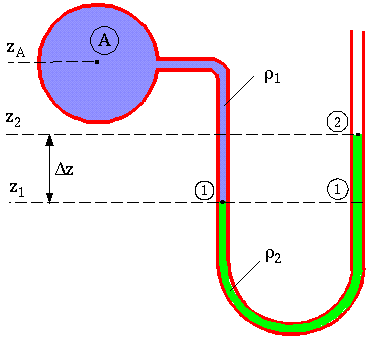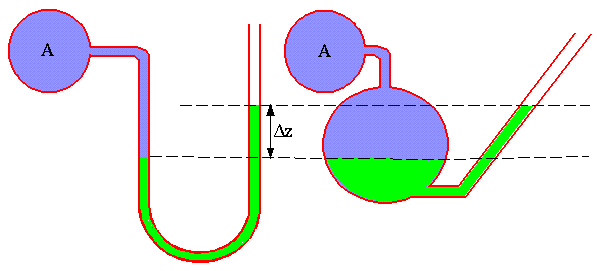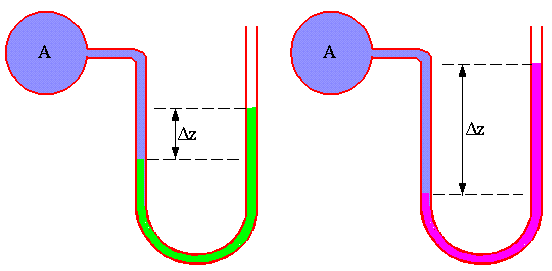
As seen in the sketch, it is formed by inverting a glass tube filled with mercury into a mercury bath. At the top of the mercury column in the tube (point 3 in the sketch), the pressure is nearly a total vacuum. The pressure at point 1 is atmospheric, and this pressure holds the mercury column at some height h, as measured by a ruler. The hydrostatics equation can be used to solve for atmospheric pressure in terms of the known values of h, g, and the density of mercury:

Some typical numbers can be heard in weather reports. For example, the weatherman may say "…the barometer reads 29 inches of mercury." This means that h = 29. inches of mercury column in the barometer. By the way, h is called the "head," which is simply pressure expressed as an equivalent column height of fluid. Using the above equation, one can calculate atmospheric pressure in more standard pressure units, such as kPa:


Again, the equation for hydrostatics is used to calculate the unknown pressure. Consider the right side and the left side of the manometer separately:

Since both points labeled 1 in the figure are at the same elevation in the same fluid, they are at equivalent pressures. Also, point 2 is exposed to atmospheric pressure, thus p2 = pa. The two equations above can be equated and solved for pA:

Finally, note that in many cases (such as with air pressure being measured by a mercury manometer), the density of manometer fluid 2 is much greater than that of fluid 1. In such cases, the last term on the right is sometimes neglected. It is good to keep all terms, however, for more accuracy.
Some "rules" to remember about U-tube manometry
- Manometer height difference does not depend on tube diameter
(except, of course, if the diameter is very small, and surface
tension effects are significant).

- Manometer height difference does not depend on tube length
(provided, of course, that the length is enough to handle the
height difference).

- Manometer height difference does not depend on tube shape
(except, of course, if the tube is of very small diameter, and
surface tension effects are significant).

Recall that the shape of a container does not matter in hydrostatics. This implies that a U-tube manometer does not have to be in a perfect U shape. There is a way to take advantage of this, namely one can construct an inclined manometer, as shown here. Although the column height difference between the two sides does not change, an inclined manometer has better resolution than does a standard vertical manometer because of the inclined right side. Specifically, for a given ruler resolution, one "tick" mark on the ruler corresponds to a finer gradation of pressure for the inclined case. - Manometer height difference does depend on the fluid
used in the manometer.

For the same pressure difference, a dense manometer liquid will have a smaller difference in column height than will a light manometer liquid. This too can be used advantageously. If a small pressure difference is being measured, it is better to use a light fluid, since the resolution and accuracy are improved. Specifically, for a given ruler resolution, one "tick" mark on the ruler corresponds to a finer gradation of pressure for the light fluid case. Why not always use a very light liquid in a manometer then? Well, for measurement of large pressure differences, the manometer may have to be too high to be practical. In such cases, a very dense liquid, such as mercury, should be used. Furthermore, the manometer liquid must be more dense than the fluid in which the pressure is being measured, for obvious reasons.Liquids are often classified according to their specific gravity, defined as the ratio of the liquid density to that of water. Liquids lighter than water, such as oil, have a specific gravity less than one, while liquids heavier than water, such as mercury, have S.G. greater than one. For mercury,




